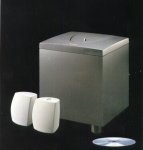Labtec LCS-2414 3-Piece Multimedia Speakers
by Mike Andrawes on May 12, 1999 10:53 PM EST- Posted in
- Smartphones
- Mobile
Quick Look |
||
Labtec LCS-2414 |
The Good | |
|
+
Great sound for the price and size |
|
| The Bad | ||
- Too many cables |
||
The first thing that comes to mind when you think of Labtec is computer accesories. These guys make everything you could possible want to add to a computer. But when you think about speakers, Labtec is probably not the first company that pops into your head. However, Labtec claims right on the box to have "America's #1 Selling Computer Speakers." Of course "best selling" does not always equate to "best," so let's see how Labtec's value model fares.
Available starting in June, 1999, the Labtec LCS-2414 is expected to retail for just under $50, making it one of the cheapest 3-piece speaker sets available on the market. If you have heard Labtec's past "value" speakers, you may not be expecting much, but the computer audio market is becoming increasingly competitive and Labtec has responded to such demands. Currently in the multimedia speaker market, just like in the rest of the computer industry, you can get a lot more for a lot less than ever before - just a year ago, a 3-piece speaker system for $50 was unheard of. And if one was released, everybody would expect very little of it. This is simply not true anymore, so do not prejudge Labtec, or anyone else, on their past products.
The most important thing to keep in my mind when buying an audio equipment is that your ears are always the best judge because everyone has different musical tastes. Keep that in mind while reading speaker reviews and, if at all possible, listen to any speakers before making a purchasing decision.
Design
Just based on the size of the box, it is obvious that these speakers do not take a lot of space. Nevertheless, it is still quite surprising to see just how small these things are once they are out of the box. The box and speakers themselves are also quite light. This all points to a design that simply is not going to sound good. But remember, listen and judge with your ears, not with specs.
The subwoofer features a wooden enclosure for improved bass response. A four inch driver fires downward in the bottom-ported enclosure. This driver is complete unprotected, so be careful with it. Since it is on the bottom, this shouldn't pose a major problem. The power button is right on top and the AC adapter plugs into the back of the sub. The sub is not shielded and is designed to be placed on the floor.
The satellites, however, are shielded, and are intended to go next to the monitor. They are incredibly tiny - less than half an inch surrounds the 2 inch drivers. Soft cloth covers the plastic grill that is underneath. The satellites are angled slightly upwards to help point the sound at the listener.
The right satellite is apparently the center to this whole system as it features the volume control and three separate audio cables permanently affixed to its backside. The volume control is a nice dial on top that allows for quick and easy adjustment of the system volume. There is no separate level control for the sub.
Those cables coming out of the right satellite include the input from the computer, the output to the sub, and the input from the sub. Why two separate cables that run to the sub? Only Labtec knows the answer to that question. As such, the LCS-2414 has an unnecessarily complicated set up that helps produce a tangled mess of wires. Fortunately, Labtec has color coded all the cables to make things a little easier.
A giant AC adapter connects to the back of the sub to power the whole system. Unfortunately, the power brick is designed such that it will block one or two additional outlets on a surge protector.
Each satellite is driven by a 2 inch driver with 5W RMS power each. The sub uses a 4 inch driver and a 15W RMS amp. Labtec does not specify a distortion level for those power ratings. The crossover frequency is also unspecified, but it appeared to be near 200Hz.
Those drivers feature "Max-X" technology that supposedly provides for high-excursion, which in turn gives greater dynamic range, improved bass response, and lower distortion. All that leads to a claimed 40Hz - 20kHz frequency response with human hearing from 20Hz - 20kHz. Few, if any, computer speakers make it all the way down to 20Hz and even many home speaker systems cannot go that low.











2 Comments
View All Comments
JackBlosseville - Tuesday, June 30, 2020 - link
Anand Lal Shimpi has shared an outstanding and purposeful blog post for the scientific community. Information regarding creative labs is explained in a very detailed manner on this blog page. And students must visit https://www.analyzedu.com/writing-services-reviews... to get reviews for their work, Keep sharing more blog pages like that.PaOnlineGambling - Thursday, November 18, 2021 - link
That's an excellent review, helped me a lot, thank you. You also must visit https://pennsylvania-online-gambling.com/tax-calcu... to find PA online gambling tax calculator.